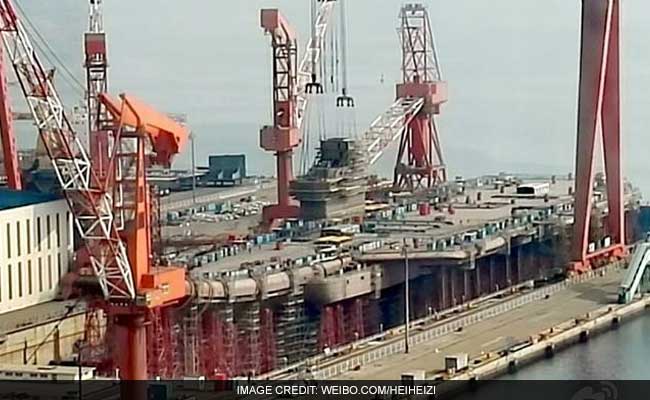These Chinese Aircraft Carrier Should Concern India
 NEW DELHI : New images indicate that China is racing towards completion of its first home-grown aircraft carrier. A month after the Indian tv channel ndtv reported that the hull of the ship, designated the Type 001-A, appeared complete, a fresh set of images indicates that the “island” of the carrier, in many ways the nerve-centre of the warship, has now been installed ahead of sea-trials commencing.
NEW DELHI : New images indicate that China is racing towards completion of its first home-grown aircraft carrier. A month after the Indian tv channel ndtv reported that the hull of the ship, designated the Type 001-A, appeared complete, a fresh set of images indicates that the “island” of the carrier, in many ways the nerve-centre of the warship, has now been installed ahead of sea-trials commencing.
The “island” consists of the warship’s bridge, aviation facilities and battle-control spaces. Radars and sensors are mounted on the island in addition to air intakes and funnels from its engines.
Completed structure of Type 001-A, China’s first home-grown aircraft carrier (right).The Type 001-A, which is being constructed at a dry dock in the port city of Dalian to the East of Beijing, will likely weigh in at 60,000 tonnes and host close to 50 aircraft including 36 J-15 fighters, a Chinese replica of the Russian Su-27.
The process of completing trials will, however, take a few years and the new Chinese carrier is unlikely to join the navy before 2020.Completed structure of Type 001-A, China’s first home-grown aircraft carrier.
The 001-A is the second Chinese aircraft carrier and its design is thought to be based on the Russian-designed Liaoning, from the Ukraine several years after the collapse of the USSR.
Significantly, new images have emerged on Chinese social media of a new variant of the J-15 fighter, designated the J-15A. The nose-wheel of the fighter features a catapult launch mechanism which clearly indicates that subsequent Chinese aircraft carriers and their strike fighters will likely be more capable.
Chinese J-15A prototype featuring nose-wheel catapult launch assembly.A catapult launch system, which is hooked up to the nose-wheel of planes launched from ships, uses a compressed steam-driven piston drive or an electromagnetic aircraft launch system (EMALS) to propel a fully-loaded fighter jet off the small deck of an aircraft carrier. At the moment, the Liaoning and the Type 001-A use a “ski-jump” ramp where fighter jets use only the power of their own engines to accelerate down the runway of the ship before being propelled off its deck.
Without the additional acceleration provided by a catapult system, China’s existing J-15 fighters have to be lighter to take off and consequently carry fewer weapons and possibly fuel, making them significantly less capable during operational deployments.
Chinese J-15A prototype featuring nose-wheel catapult launch assembly.The pace of completion of China’s first home-grown aircraft carrier is a matter of concern for the Indian Navy. India’s indigenous aircraft carrier, named Vikrant (after the first carrier to enter its fleet), is nowhere close to completion despite having been launched in Kochi a full three years before China’s 001-A.
Vikrant, India’s first indigenous aircraft carrier. (File)
The Vikrant will, at the very least, take nine years from start to finish point of joining the navy. The Chinese warship, on the other hand, will have made that same journey in three years.
Though the hull, superstructure and engines of the Vikrant have been integrated, its primary sensor, the Israeli MF-STAR (Multi-Function Surveillance, Track and Guidance) radar and Barak 8 Long Range surface to air missiles have not yet been acquired for this project.

